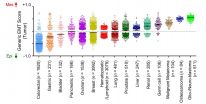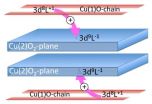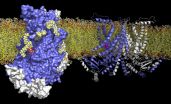Scientists develop scoring scheme that predicts ability of cancer cells to spread
Novel system by the Cancer Science Institute of Singapore and collaborators opens up the possibility to explore new treatments that suppress the spread of cancer in patients
2014-11-13
(Press-News.org) Scientists at the Cancer Science Institute of Singapore (CSI Singapore) at the National University of Singapore (NUS) and their collaborators have developed a scoring scheme that predicts the ability of cancer cells to spread to other parts of the body, a process known as metastasis. This system, which is the first of its kind, opens up the possibility to explore new treatments that suppress metastasis in cancer patients. The findings were published in EMBO Molecular Medicine in September.
Led by Professor Jean Paul Thiery, Senior Principal Investigator, and Dr Ruby Huang, Principal Associate, both from CSI Singapore, the scientists developed a scoring scheme which monitors the epithelial-mesenchymal transition (EMT) mechanism. This process was shown to play a role in a large number of cancer-related events, including cancer invasion, metastasis, and chemo-resistance. To date, there are no existing tools to systematically quantify the EMT status of tumours. The newly-developed EMT scoring is thus a promising, versatile tool for investigating EMT roles and dynamics in the progression, treatment response and survival across different types of cancer. It can also be integrated with other molecular tests, such as the detection of mutations of cancer genes, to help identify patients at higher risks for treatment failure and decreased survival.
EMT mechanism and cancer metastasis
Cancer metastasis is responsible for 90 per cent of cancer deaths. One of the mechanisms of metastasis is through the EMT process, where tumour cells lose adhesion contacts with their neighbouring cells at the primary tumour site, and gain the ability to move to a secondary site. The ability to stay in tight contact is an important feature of epithelial cells whereas the ability to gain movement is a characteristic of mesenchymal cells. Tumour cells which undergo the EMT process lose their epithelial features and gain invasive, migratory properties typical of mesenchymal cells.
The EMT mechanism has a varying impact on different populations of cancer cells as they respond differently to the EMT cues. Not every cancer cell will undergo the same degree of loss of cell adhesion ability or gain the ability to move spontaneously, which is known as motility. As a result, tumours from different patients will exhibit a wide range of differences in the status of their EMT. To determine with precision the EMT status of the tumour, the research team developed a quantitative modelling system.
How the EMT scoring scheme was developed
In this study, the researchers utilised a total of 13,000 samples from publicly available databases containing gene expression information for more than 15 different types of cancers. A computational modelling scheme of EMT was established to define tumours having the most epithelial features and tumours having the most mesenchymal features. Subsequently, the tumours were rated on a continuous spectrum of different EMT scores. Tumours with mixed epithelial and mesenchymal features are at the in-between state. This transitional state signifies cancer cell populations that might become truly mesenchymal. Patients who have tumours at this intermediate state may be at higher risks compared to those with tumours at the epithelial state.
The clinical information from the databases, including patient survival and treatment responses, was compared against the EMT scoring scheme. The research team showed that the EMT scoring they developed has a good correlation with previously published, cancer-specific EMT signatures. They used this scoring scheme to establish an EMT spectrum across various cancers and noted good correlation between cancer cell lines and tumours. The scientists concluded that this scoring scheme may enable the objective and systematic investigation of EMT in cancer progression, survival and throughout the clinical response to therapy.
Dr Huang said, "After announcing this generic EMT scoring scheme at an international cancer meeting in the United States, people came to me and thanked us for providing the field with a useful tool to help them determine EMT. Now, researchers no longer need to scratch their heads to find out what markers to use to represent EMT in their systems. We have provided the solution."
"It's about time that someone developed an EMT scoring scheme and we are very happy and excited that it came from our team," said Prof Thiery. In 2002, Prof Thiery pioneered in indicating the role of EMT during cancer progression. As a result, this research field experienced an exponential growth in knowledge over the last 12 years, including implicating the current knowledge about cancer stem cells.
INFORMATION:
Future research
The scoring scheme has received interest from the scientific community and the team has started to compute EMT scoring for other researchers upon request. Currently, the team is developing a simplified diagnostic test to allow research or clinical labs to assess the EMT status of research or clinical samples.
[Attachments] See images for this press release:

ELSE PRESS RELEASES FROM THIS DATE:
2014-11-13
Swedish materials researchers at Linköping and Uppsala University and Chalmers University of Technology, in collaboration with researchers at the Swiss Synchrotron Light Source (SLS) in Switzerland investigated the superconductor YBa2Cu3O7-x (abbreviated YBCO) using advanced X-ray spectroscopy.
Their findings are published in the Nature journal Science Reports.
YBCO is a well-known ceramic copper-based material that can conduct electricity without loss (superconductivity) when it is cooled below its critical temperature Tc=-183° C. Since the resistance and ...
2014-11-13
People on the autistic spectrum may struggle to recognise social cues, unfamiliar people or even someone's gender because of an inability to interpret changing facial expressions, new research has found.
According to the study by academics at Brunel University London, adults with autism spectrum disorders (ASD), though able to recognise static faces, struggle with tasks that require them to discriminate between sequences of facial motion or to use facial motion as a cue to identity.
The research supports previous evidence to suggest that impairments in perceiving biological ...
2014-11-13
Membranes are thin walls that surround cells and protect their interior from the environment. These walls are composed of phospholipids, which, due to their amphiphilic nature, form bilayers with dis-tinct chemical properties: While the outward-facing headgroups are charged, the core of the bilayer is hydrophobic, which prevents charged molecules from passing through. The controlled flow of ions across the membrane, which is essential for the transmission of nerve impulses, is facilitated by ion channels, membrane proteins that provide gated pathways for ions. Analogous ...
2014-11-13
A cat always lands on its feet. At least, that's how the adage goes. Karen Liu hopes that in the future, this will be true of robots as well.
To understand the way feline or human behavior during falls might be applied to robot landings, Liu, an associate professor in the School of Interactive Computing (IC) at Georgia Tech, delved into the physics of everything from falling cats to the mid-air orientation of divers and astronauts.
In research presented at the 2014 IEE/RSJ International Conference on Intelligent Robots and Systems (IROS), Liu shared her studies of mid-air ...
2014-11-13
Weather, which changes day-to-day due to constant fluctuations in the atmosphere, and climate, which varies over decades, are familiar. More recently, a third regime, called "macroweather," has been used to describe the relatively stable regime between weather and climate.
A new study by researchers at McGill University and UCL finds that this same three-part pattern applies to atmospheric conditions on Mars. The results, published in Geophysical Research Letters, also show that the sun plays a major role in determining macroweather.
The research promises to advance ...
2014-11-13
Duchenne muscular dystrophy is the most common neuromuscular disease of children (affecting 1 boy in 3500-5000 births). It is caused by a genetic defect in the DMD gene residing on the X chromosome, which results in the absence of the dystrophin protein essential to the proper functioning of muscles.
The treatment being developed by researchers at Atlantic Gene Therapies, Généthon and the Institute of Myology, is based on the use of an AAV vector (Adeno Associated Virus) carrying a transgene for the skipping of a specific exon which allows functional dystrophin ...
2014-11-13
After graphene was first produced in the lab in 2004, thousands of laboratories began developing graphene products worldwide. Researchers were amazed by its lightweight and ultra-strong properties. Ten years later, scientists now search for other materials that have the same level of potential.
"We continue to work with graphene, and there are some applications where it works very well," said Mark Hersam, the Bette and Neison Harris Chair in Teaching Excellence at Northwestern University's McCormick School of Engineering and Applied Science, who is a graphene expert. ...
2014-11-13
High blood pressure - already a massive hidden killer in Nigeria - is set to sharply rise as the country adopts western lifestyles, a study suggests.
Researchers who conducted the first up-to-date nationwide estimate of the condition in Nigeria warn that this will strain the country's already-stretched health system.
Increased public awareness, lifestyle changes, screening and early detection are vital to tackle the increasing threat of the disease, they say.
High blood pressure - also known as hypertension - is twice as high in Nigeria compared with other East ...
2014-11-13
Researchers at The University of Texas have found that compared to Caucasian Americans, African Americans have impaired blood flow regulation in the brain that could contribute to a greater risk of cerebrovascular diseases such as stroke, transient ischaemic attack ("mini stroke"), subarachnoid haemorrhage or vascular dementia. These findings were published in Experimental Physiology, the journal of The Physiological Society.
Cerebrovascular diseases can result from reduced blood flow in affected areas of the brain. It is still unclear why African Americans are at higher ...
2014-11-13
Needles almost too small to be seen with the unaided eye could be the basis for new treatment options for two of the world's leading eye diseases: glaucoma and corneal neovascularization.
The microneedles, ranging in length from 400 to 700 microns, could provide a new way to deliver drugs to specific areas within the eye relevant to these diseases. By targeting the drugs only to specific parts of the eye instead of the entire eye, researchers hope to increase effectiveness, limit side effects, and reduce the amount of drug needed.
For glaucoma, which affects about 2.2 ...
LAST 30 PRESS RELEASES:
[Press-News.org] Scientists develop scoring scheme that predicts ability of cancer cells to spread
Novel system by the Cancer Science Institute of Singapore and collaborators opens up the possibility to explore new treatments that suppress the spread of cancer in patients




